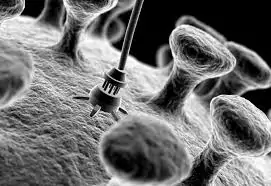
By Johannes Helmold

✅ AI Essay Writer ✅ AI Detector ✅ Plagchecker ✅ Paraphraser
✅ Summarizer ✅ Citation Generator
Among all the technological wonders of modernity, there is one that, in perspective, can revolutionize reality. During the recent two centuries, there have been several such discoveries: electricity, radio waves, flight, nuclear energy, the Internet, and others. But today humanity stands on the edge of something completely new: nanotechnology.
To start the explanation of nanotechnology properly, let us figure out what is this “nano” part of the word. “Nano” is a prefix used in the metric system, meaning one billionth part of something; so, nanometer, a standard measurement unit, is a 0,000000001 part of a meter. To be able to imagine how small this value is, let us refer to examples. One inch is 25,400,000 nanometers. Even a more illustrative example: a sheet of regular office A4 paper is 100,000 nanometers thick (Nano.gov). Human hair is about 80,000 nanometers thick (Nanowerk.com). Generally speaking, “nano” in “nanotechnology” means “very small, tiny.”
So, in this case, what exactly is nanotechnology? According to the U.S. National Nanotechnology Initiative, nanotechnology implies the ability to understand and control matter at dimensions between approximately from 100 up to one nanometer; it also involves imaging, measuring, modeling, and manipulating matter at the estimated length scale (Nanowerk.com). At the nanoscale, matter possesses unique properties; properties of materials behave under atomic and molecular rules, and this is why nanotechnology is so advanced: researchers can gain control over these unique properties to create new tools and products in areas of science and engineering (nnin.org). For example, nanotechnology allows to construct materials and structures at an atomic scale; this means scientists can “build” materials from atoms and molecules.
Nanotechnology is still in the process of development, but nevertheless, it can already surprise humanity with wonders that were impossible several decades ago. For example, there are special carbon nanotubes that are able to turn into an artificial muscle; there is a 3D printer that can print new cancer drugs; there already exist self-healing materials, such as concrete that fills in its cracks to ship hulls that knit back together; viruses were created that convert pressure into electrical energy, and so on. These and other inventions are the beginning of a new technological era (io9.com).
Nanotechnology is a relatively new branch of science that can revolutionize the reality we live in today. Nanotechnology operates with matter at dimensions between one to one hundred nanometers. This allows scientists to gain control over the unique properties that matter at such a small scale possesses. Self-healing materials, artificial muscle, and other wonderful inventions are only the beginning of the new era of technology.
References
“What is Nanotechnology?” What Is Nanotechnology? N.p., n.d. Web. 27 Aug. 2015. <http://www.nano.gov/nanotech-101/what/definition>
“What is Nanotechnology?” Nanowerk. N.p., n.d. Web. 27 Aug. 2015. <http://www.nanowerk.com/nanotechnology/introduction/introduction_to_nanotechnology_1.php>
“What is Nanotechnology?” National Nanotechnology Infrastructure Network. N.p., n.d. Web. 27 Aug. 2015. <http://www.nnin.org/news-events/spotlights/what-nanotechnology>
“8 Incredible Nanotechnologies that Actually Exist Today.” Io9. N.p., n.d. Web. 27 Aug. 2015. <http://io9.com/5967198/8-incredible-nanotechnologies-that-actually-exist-in-the-real-world>
Follow us on Reddit for more insights and updates.




Comments (0)
Welcome to A*Help comments!
We’re all about debate and discussion at A*Help.
We value the diverse opinions of users, so you may find points of view that you don’t agree with. And that’s cool. However, there are certain things we’re not OK with: attempts to manipulate our data in any way, for example, or the posting of discriminative, offensive, hateful, or disparaging material.